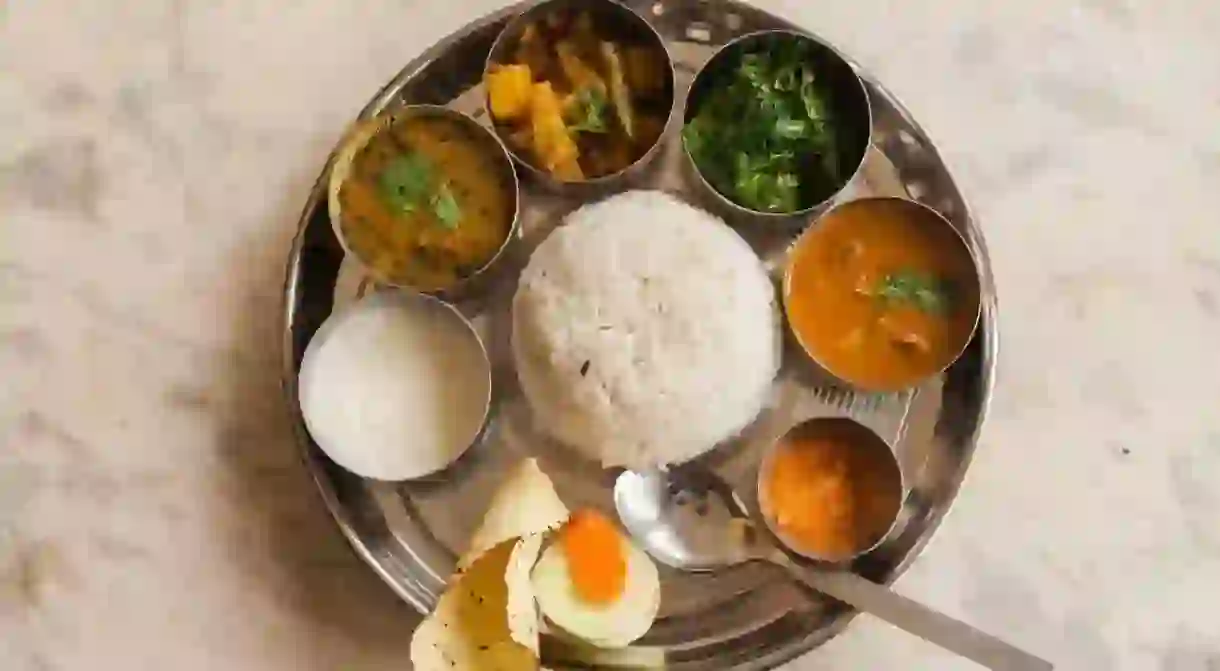Traditional Nepali Dishes You Need to Try at Least Once

Ask any Nepali what their favourite food is and you’re likely to get dhal bat as your answer. While it’s imperative that you eat at least a few hearty servings of the national dish consisting of lentils and rice on your trip, there are plenty of other culinary delights that you should try while in Nepal. To give you a flavour of what to expect, we’ve hand-picked – and tasted – some of the best.
On Culture Trip’s specially curated 11-day Nepal adventure, led by our Local Insider, you’ll have the chance to savour authentic Nepali cuisine and learn how to make traditional momo dumplings in a cooking class.
Dal Bhat
To call this dish a staple of Nepali cuisine would be an understatement – it’s so much more than just rice and lentils. When served in a restaurant or at home, the rice and lentil curry is accompanied by a variety of seasonable vegetable and meat curries – such as spinach, potato, mushroom, chicken, or buffalo – as well as a salad, pickles, papadams and curd. It’s not just a dish – it’s a wholesome, satisfying meal. It’s no wonder it’s a source of national pride.

Momos
While Momos are usually called Tibetan dumplings, the truth is, they’re usually just as good – or even better – in Nepal. They’re a favourite among Nepalis – not only of Tibetan origin – so it’s safe to call them Nepali food. Rice paper wrappers are stuffed with finely chopped vegetables, minced buffalo or chicken and are steamed, deep-fried, or added to a spicy soup. They’re also served with large helpings of spicy pickles for dunking. Momos are always hand-made fresh to order, so don’t be surprised if they take a while to arrive – they’re well worth the wait.
Sel Roti
As Nepal’s answer to the doughnut – because they’re deep-fried and round – Sel Roti are in fact much less sweet than the kind of doughnut you’re used to. Although they do have a hint of sweetness. They’re made in Nepali homes during celebrations and certain festivals – especially Maghe Sankranti and Tihar – and you’ll commonly find them at roadside snack stalls.

Gundruk
Wildly popular in Nepal, Gundruk is made by fermenting leafy green vegetables. It’s commonly made into a pickle, known as Gundruk Ko Achar. The taste is difficult to describe – slightly mushroomy and salty comes to mind. It perfectly complements Nepali curries and a dollop of it is usually added to a Dal Bhat meal.
Maasko Bara
Newari is a Nepali ethnic group of people that were the original inhabitants of the Kathmandu Valley – where their distinct culture, cuisine, architecture and language still have a strong presence in the capital. Newari food shares plenty of similarities with Nepali cuisine but has a distinct character of its own. Bara – also spelt “Bada” – are a popular Newari snack, akin to a thick, savoury rice-flour pancake. It can be eaten plain, with an egg cracked on top or with minced buffalo meat.

Chataamari
Chataamari is another favourite Newari snack that is extremely popular in Kathmandu, in particular. It’s sometimes called a “Nepali pizza”, but that’s only really because of its round shape. It’s a rice-flour crepe – thinner than Bara – that is cooked with a variety of savoury toppings, such as chopped onions, fresh coriander, minced meat, egg, chillis and mixed spices.
Yomari
Yomari is such a special food that it has its own festival – usually celebrated in December – called Yomari Punhi. The Newari festival marks the end of the rice harvest and sweet Yomari are made and eaten on this day. The pointed, fish-shaped dumplings are made from rice flour and stuffed either with a sweet molasses mixture or a coconut one – either is delicious.
Aside from Newari households during the Yomari Punhi Festival, Yomari is available year-round at the Village Cafe on Pulchowk in Lalitpur – and in the bakery section of the nearby Bhat Bhateni Supermarket. They’re hard to find elsewhere outside the festival time.

Chiura
Chiura is a somewhat acquired taste. It’s rice that has been beaten flat and dried to keep it fresher for longer. It can be quite dry to eat, so it’s best as an accompaniment to curries. Be warned that it is very filling – don’t eat too much at once.
Sandheko
This spicy Newari salad is usually made with potatoes or peanuts – as well as lots of chillies, raw onions, fresh coriander and spices – and is served cold. It’s a very popular bar snack.
Juju Dhau
Juju Dhau – or “King Curd” – is a thick, creamy, sweetened yoghurt, served in clay pots in the city of Bhaktapur. It’s made with buffalo milk, so it’s much richer than regular cow’s milk yoghurt. It’s an important accompaniment to many Newari celebrations and a must-try when visiting Bhaktapur. Grab a pot from a local street vendor for the most authentic taste.














